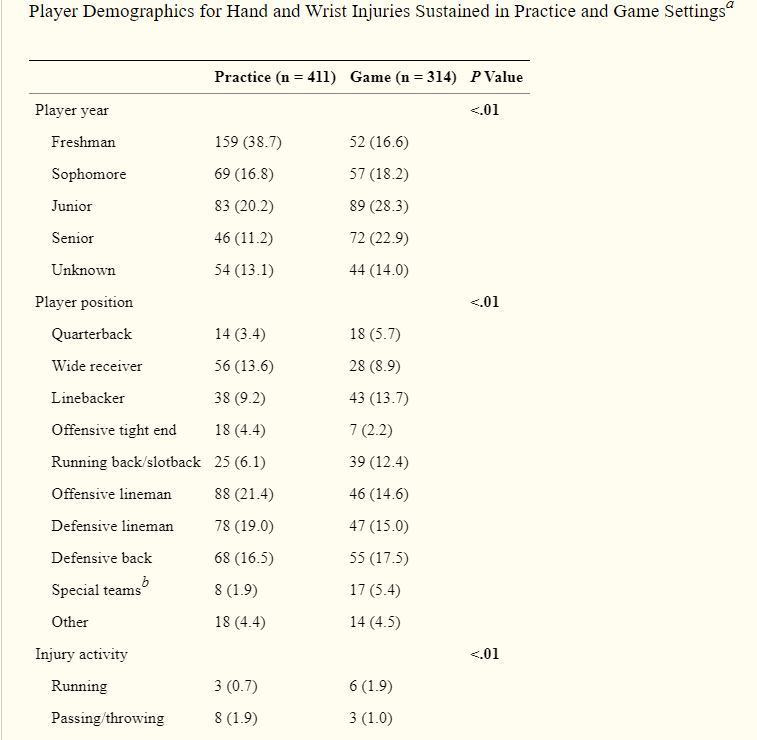The list of injuries goes on and on- but it’s important to remember that Tua Tagoviola has no documented injuries from his playing days in high school. Furthermore, to truly understand the range of outcomes Tua’s career holds due to injuries, it’s crucial to look at his specific history and the medical research.
What Happened?
March 2018: fractured thumb on throwing hand (required surgery)
December 2018: left high ankle sprain (required surgery)
October 2019: right high ankle sprain (required surgery)
November 2019: right hip fracture and dislocation
In his first day of practice as a quarterback in the Spring of 2018, Tua was transported to the hospital for a thumb injury. The timing and probabilities were a statistical anomaly. First, although not unheard of in quarterbacks, finger fractures are mostly seen in linemen, wide receivers and defensive backs. In this study done on NCAA athletes from 2009-2014, Bartels, Hevesi, Wyles, Macalena, Kakar and Krych found that for every 1,0000 athlete exposures the in-practice hand/wrist injury rate is 0.51. That’s compared to 3.61 for every 1,000 in-game athlete exposures. Worded differently, the injury was not only rare, but rare in the sense that it was in a practice. Additionally, only 3.5-percent of these injuries occured to the quarterback position and only 1.7-percent required transportation to the hospital. The point of all of these statistics is that his thumb fracture seems to have been an anomaly and has not bothered him since.
Moving on to December of 2018, Tua suffered his first high ankle sprain to the left ankle. Then in October of 2019, suffered his second high ankle sprain to the right ankle. A high ankle sprain is damage to the connective tissue that holds together the shin bone and the fibula bone where they meet at the ankle. This occurs when the foot is planted and forcibly compressed down and/or outwardly. These injuries are slow to heal due to the poor blood flow to the area. Again, these injuries are most commonly seen in running backs and wide receivers, not quarterbacks. In fact, among skill players quarterbacks accounted for only 5.1-percent of high ankle sprains from 2009-2015 compared to 13-percent for running backs and wide receivers each.
https://www.ncbi.nlm.nih.gov/pmc/articles/PMC6444788/
Table courtesy of Bartels et. al.
Then there’s the big one. The hip/pelvis dislocation and fracture in November of 2019. Imagine a baseball sitting in a water glass and essentially you’re picturing the ball and socket joint of the hip. The femur (thigh bone) ends in a ball and sits securely positioned in the cup-like shape of the pelvis. When Tua was taken down, the ball of the femur was forced backwards and out of the socket tearing the labrum holding it in place and fracturing the posterior aspect of the cup-like pelvis. Hip/pelvis injuries account for only 3-percent of all NFL (and presumably NCAA) injuries--a third of which are muscle strains in wide receivers and defensive backs. As severe and serious as this injury is, Tua is well on his way to recovery in the short term having passed his most recent physical after allegedly “failing” a couple from NFL teams. However, these physicals are convoluted and subjective as the criteria changes on a team-to-team basis. Overall, tissue healing times and basic biology inform us enough to know that his hip is on the mend.
The Spin
If you’ve made it this far and can’t help but think to yourself “Man, how unlucky is this guy?” you are not alone. The medical research very clearly shows that Tua’s injury history is one of the most unlucky in recent history. Nevertheless, NFL teams are now faced with a decision. As much as I want to root for this kid, it’s impossible to ignore the big picture. Despite a 92-percent return to pre-level of performance following high ankle sprain surgery, and plenty of research suggesting that the most talented players rebound the best from injuries, the overarching concern with Tua is the potential for early-onset osteoarthritis. For every major trauma a joint undergoes (i.e. hip fracture/dislocation and two high ankle surgeries), the faster and the higher the likelihood this can occur. Look no further than Todd Gurley as an example of this. In the end, there are two ways NFL teams can view Tua:
- Lightning in a bottle- an elite athlete with extreme bad luck who’s now in a position to play a career that, although potentially abbreviated, can be magical.
- A liability- a “fragile” and “injury prone” player who is one play away from hitting the reset button on a franchise who decides to take a chance on him.
Next week, those teams will tell us exactly where they stand when it comes to Tua Tagovailoa.








